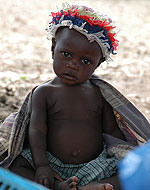Author and Page information
- This page: https://www.globalissues.org/article/715/today-21000-children-died-around-the-world.
- To print all information (e.g. expanded side notes, shows alternative links), use the print version:
The silent killers are poverty, hunger, easily preventable diseases and illnesses, and other related causes. Despite the scale of this daily/ongoing catastrophe, it rarely manages to achieve, much less sustain, prime-time, headline coverage.
Source: State of the World’s Children, 2010 , UNICEF, p.18-19. See also ChildInfo.
Why is this tragedy not in the headlines?
Back in 2000, UNICEF’s Progress of Nations report for that year tried to put these numbers into some perspective:
The continuation of this suffering and loss of life contravenes the natural human instinct to help in times of disaster. Imagine the horror of the world if a major earthquake were to occur and people stood by and watched without assisting the survivors! Yet every day, the equivalent of a major earthquake killing over 30,000 young children occurs to a disturbingly muted response. They die quietly in some of the poorest villages on earth, far removed from the scrutiny and the conscience of the world. Being meek and weak in life makes these dying multitudes even more invisible in death.
Unfortunately, it seems that the world still does not notice. It might be reasonable to expect that death and tragedy on this scale should be prime time headlines news. Yet, these issues only surface when there are global meetings or concerts (such as the various G8 summits, the Make Poverty History campaign in 2005, etc).




Furthermore, year after year, we witness that when those campaigns end and the meetings conclude, so does the mainstream media coverage.
It feels as though even when there is some media attention, the ones who suffer are not the ones that compel the mainstream to report, but instead it is the movement of the celebrities and leaders of the wealthy countries that makes this issue newsworthy.
Even rarer in the mainstream media is any thought that wealthy countries may be part of the problem too. The effects of international policies such as structural adjustments, the current form of globalization, and the influence wealthy countries have had for decades on these processes is rarely looked at.
Instead, promises and pledges from the wealthy, powerful countries, and the corruption of the poorer ones — who receive apparently abundant goodwill — make the headlines; the repeated broken promises, the low quality and quantity of aid, and conditions with unfair strings attached do not.
Accountability of the recipient countries is often mentioned when these issues touch the mainstream. Accountability of the roles that international institutions such as the World Bank and IMF, and their funders (the wealthy/powerful countries), rarely does. The risk is that citizens of these countries get a false sense of hope creating the misleading impression that appropriate action is taken in their names.
It may be harsh to say the mainstream media is one of the many causes of poverty, as such, but the point here is that their influence is enormous. Silence, as well as noise, can both have an effect.
Recent headlines in context
When this page was initially written, the BBC’s top story on prime time television was about a British child kidnapped in Portugal. This is definitely a tragic story that needs reporting, but why, for the BBC and other British media outlets that pride themselves in outstanding international media coverage, is the plight of millions of children not daily headlines?
Another recent tragedy that sustained days of headline and prime time media coverage was the Virginia Tech massacre’s in the US. When media critics at Media Lens asked for the BBC’s rationale for such sustained coverage compared to more people dying each day in Iraq and receiving just a few minutes in comparison, the BBC responded that it happens every day in Iraq. See Putting Virginia Tech in Perspective for the follow up from Media Lens.
Some people fear there will be fatigue at hearing those depressing stories all the time, or the advertisers will pressure the media companies to put a bit more entertainment or good news on so that buying moods are not affected.
And does it have to be just bad news? Despite the tragedy, there is some measure of progress, which, perhaps with further public attention, could spur on more efforts in these areas and highlight important related issues.
However, news of tragedies in Iraq are also depressing, but nevertheless do received regular headline coverage.
Also there is worry that the lack of sensationalism attached to reporting the same news story each day will result in lower television viewing ratings and this may have various consequences—especially where advertising is concerned.
Finally there is the question of whether people want to hear about such depressing news stories. After all the media feels it is delivering what its viewers would like. However, it is difficult for people to know what they do or do not want to see, if they are never given the options of the alternatives. If the magnitude of this suffering is hardly reported in a sustained manner, how can viewers judge whether they wish to watch it or not?
About Child Deaths
Cautious optimism in reducing child mortality
Notes and Sources
Sources for child deaths
Sources for Asia Tsunami comparison
This site’s article, Asian Tsunami in December 2004, notes that approximately 230,000 people died in that disaster.
Sources for Iraq comparison
For the Iraq estimate, the John Hopkins study (reported in the Lancet) found 400,000 to 950,000 deaths since the 2003 Iraq invasion (average of some 655,000). .
As an aside, George Bush and many others dismissed this study in the Lancet as lacking credibility, using discredited methodologies, and instead used the Iraq Body Count statistics (of 30,000 at the time, though it is now reported at about 66,000).
If Iraq Body Count statistics are to be used, then the number of days in which child deaths match the post 2003 Iraq death toll is just two or three days. The Iraq Body Count statistics are often criticized because they rely on mainstream media reporting, which is heavily censored and managed by the US in Iraq. Nonetheless they provided criticism of the John Hopkins study (often referred to as the Lancet study as that is where it was published).
The authors of the study defended it noting that they used the very methodology that the US government is teaching others (and thus dismissed Bush’s claim of using discredited methodologies). The full report in the Lancet also notes that casualty reporting in war time tends to be grossly underestimated, so their numbers may not be as hard to accept as it initially sounds. This caused controversy when reported in October 2006, and is detailed further on this site’s Iraq media reporting section which includes the relevant links.
Throughout this site, many issues are discussed that rarely sustain (or enter) mainstream media coverage. The articles listed below are ones that provide a bit more detail behind the above figures.
See also Poverty.com for more interactive information and ChildInfo for more data based on the UNICEF statistics.
Author and Page Information
- Created:
- Last updated:

